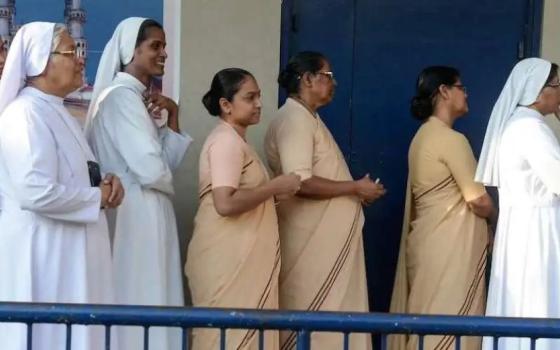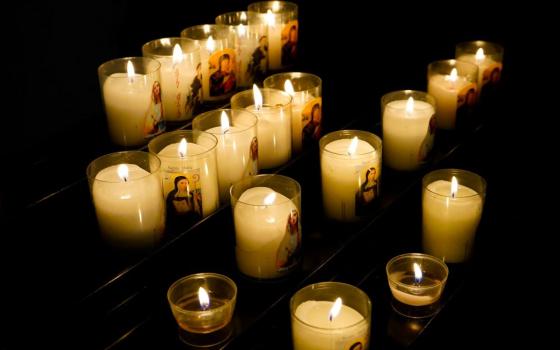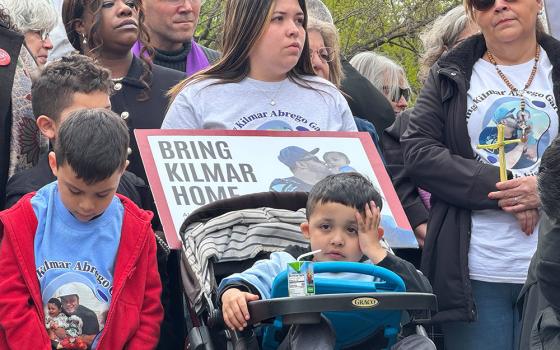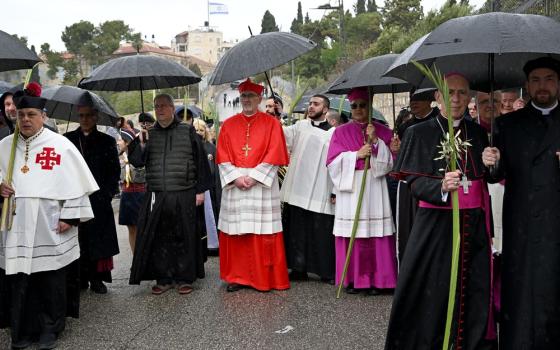U.S. soldiers sit as French troops walk during a joint U.S. and French amphibious landing operation showcase at Omaha Beach June 4, 2024, two days ahead ahead of the 80th anniversary of the 1944 D-Day landings in Saint-Laurent-sur-Mer in the Normandy region of France. (OSV News/Benoit Tessier, Reuters)
It was an emotional welcome when 48 veterans from around the U.S. arrived at the Deauville-Normandy Airport June 4 on board a special flight from Atlanta to celebrate the 80th anniversary of D-Day on June 6.
France's first lady Brigitte Macron and top French officials were there to greet them along with French children, some dressed in clothing imitating the 1944 military uniforms.
"Welcome to France," Brigitte Macron said, speaking in English, expressing her "deepest respect" and "deepest love" to the veterans, The Associated Press reported.
"You fought for our freedom. You have always decided to educate the younger generation so that we never forget," she said.
The first lady was seen hugging the veterans, greeting each with traditional two kisses on the cheek. U.S. military men, most over 100 years old, appeared in good, cheerful spirits as they arrived at Normandy.
U.S. President Joe Biden arrived in Paris June 5 and is scheduled to attend the official state celebration in Normandy June 6 — next to "Bloody Omaha" and other beaches which saw thousands of Allied soldiers sacrifice their lives to save France and Europe from German Nazi occupation.
The anniversary celebrations will be attended by Normandy's Catholic bishops, led by Bishop Jacques Habert of Bayeux-Lisieux, as well as the president of the French bishops' conference, Archbishop Éric de Moulins-Beaufort of Reims.
On June 8, in Bayeux Cathedral, Habert will bless a marble plaque bearing the names of 138 priests, seminarians, and men and women religious who disappeared during World War II, either as victims of air attacks or they were deported to death camps for acts of resistance.
For the first time, the names of religious sisters who died in the Allied bombing raids that accompanied D-Day will be honored. Among them were almost 100 nuns who died under Allied bombardment on June 6, 1944.
A diocesan priest, Father Pascal Marie, has been working since 2004 to find the names of religious sisters who perished in northern France's Normandy on that day. "The lists of victims drawn up in 1944 mentioned the names of the priests, but not those of the nuns," he told OSV News.
"Only the communities were mentioned. I found it poignant that we did not even know the names of these women who had died. There were still a few nuns who had heard the moving and terrible stories of what had happened at that time. Their testimonies had to be collected before it was too late!" he said.
Advertisement
Marie began researching community archives and interviewing elderly nuns.
"Investigations were not easy, due to the fact that nuns have a nun's name in addition to their civil name," he said. He also surveyed the families, from whom he found a great deal of information.
"Our diocese is still strongly marked by D-Day. We live in towns that almost all had to be rebuilt after the war. All families have memories of this period passed down to them by their parents or grandparents. Thanks to the families, I was even able to find photos," Marie told OSV News.
Among the religious communities tragically affected by Allied bombing that accompanied the beach landings — were Little Sisters of the Poor at St. Thérèse's convent in Lisieux. Of the 17 sisters, 13 were killed, according to Marie.
"I found a photo of the four survivors, among whom were two Spanish, an Italian and a Chinese," Marie recounted. "One of the Spanish, Sister Josephine, had said on June 6, 1944: 'If anything happens, may the Lord grant me the grace to pray until the end.'"
During the night, a bombing raid decimated the convent. On the morning of June 7, rescuers heard Josephine praying in Spanish for several hours. Marie found the testimony of one of the nuns who had survived and wrote: "For the rest of my life, I will remember the sight of Sister Josephine's body when we discovered it. The explosion had thrown her to the top of a beam. Her arms stiff with death, she raised her two clasped hands to the sky."
"We also have the story of the death of the Chinese sister," Marie added. She found herself alive after the same bombing, but trapped under a huge bookcase. When the rescuers reached her, she insisted that they eat something before digging her out, because they had been working for hours. Unfortunately, she later died of her injuries," Marie said.
Marie also spoke about the Benedictine Abbey of Notre-Dame-du-Pré in Lisieux, founded in 1050, and at whose school St. Thérèse of Lisieux had studied.
On June 7, 1944, some 20 nuns were killed in a matter of minutes. The monastery was destroyed, and with it the archives of its thousand-year history.
"The mother superior and the subprioress were killed," Marie recounted. "The few survivors found themselves among the ruins. The person in charge of liturgy addressed the others: 'Sisters,' she said, 'I see that some of you have kept your books of hours with you. We are going to do what we were made to do: sing the Divine Office.' And so, on June 7, amidst the corpses, they began to sing the Liturgy of the Hours," Marie recounted.
"I met several of the sisters who had known the survivors, and they told me about it," Marie said. "This courage and strength is an example to us all."
Marie can cite many other examples, including that of the nuns of several monasteries in Caen, the ancient capital of the Duchy of Normandy, three-quarters of which was destroyed by the bombing raids in 1944. One of the Ursuline nuns was the only survivor of her convent.
On June 8, the plaque to be unveiled also will bear the names of seminarians and priests killed in action or deported because they were members of the Resistance.
"Among them is Father Jean Daligault, who is a deeply moving figure," Marie explained.
"He was arrested by the Gestapo (German Nazi police) in 1941, sent to prison, then to a concentration camp. He died in Dachau, in April 1945, shot in the back of the head the day before the camp was liberated," the priest said.
"After his death, it was discovered that he had continued to paint in prison and in the camp," Marie recounted. "He used all the materials at his disposal, the straw from his mattress, shreds of newspaper, and rust for his paint. He befriended a German priest who secretly brought out (Daligault's) works."
Over 150 of the French martyr priest's works were eventually collected.
"He painted life in the camps, as well as portraits of himself, which show the progress of his physical decline," Marie explained. "These impressive testimonies are now on display at the Besançon museum in eastern France."
"It is very moving to think of all those civilian victims," Marie told OSV News. "Among them, the forgotten nuns contributed in their own way to the efforts of all those who helped liberate France. The marble plaque bearing their names will touch many families. Many of these nuns had no graves since their bodies disappeared in the flames."
On June 8, when the bishop blesses the marble plaque, the sister of one of the nuns will be present. She is now 101 years old.
From dawn on June 6, a dozen parish Masses will be celebrated on the landing beaches. The official international commemoration ceremony will take place in Saint-Laurent-sur-Mer, the small town bordering Omaha Beach, with French and U.S. presidents present, among other heads of state.
This is the beach on which over 34,000 American soldiers landed on June 6, 1944. An estimated 2,500 were lost that day.






